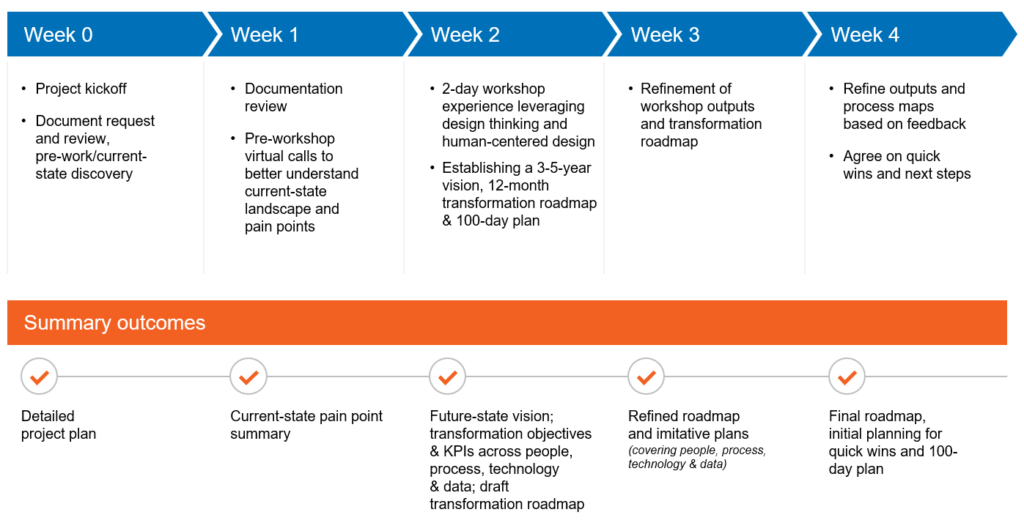You spend six, seven, eight figures on a transformation project to modernize operations, outpace competitors, and deliver stronger margins. But months or years into the project, ROI is still opaque, and the change coalition is exhausted from delays, roadblocks, and misalignment. If you make it to go-live, employees resent or don’t adopt the new systems and processes.
There’s got to be an easier way.
CrossCountry Consulting’s transformation management framework is a proven three-phase model for understanding transformation goals, executing on the change mission, and creating timely, tangible outcomes. Better yet, it can be applied to projects throughout the business, from Finance and IT to Risk and Operations.
Leveraging elements of human-centered design (HCD), Kaizen, Lean Six Sigma, and Agile, this framework rapidly identifies challenges, drives toward solutions, and generates business value quickly.
Let’s explore what that looks like in reality.
A Hands-On Way to Capture Untapped Transformation Value
Having led thousands of transformation projects over the years, we’ve found this format has five key advantages:
- It’s faster than traditional discovery models. That means you reach the finish line sooner and can begin generating ROI on time as planned.
- It’s more affordable. When 70% of transformation initiatives fail, there’s massive waste. With a more strategic approach, you can make the transformation roadmap clear, practical, and achievable while keeping all parties accountable in the name of progress. No more lengthy delays, scope creep, and sunk costs.
- Better ideas are generated. When employees at all levels of the business have a seat at the table and their ideas and concerns are listened to, it creates an environment of transparency, collaboration, and organic problem-solving, the exact conditions for great ideas to flow freely.
- People buy in to outcomes. By building better adoption habits along the way and including employees from the start, it’s much easier to gain buy-in across different departments and improve the probability of success.
- It’s fun. Setting aside dedicated time to be creative and forward-looking within a cross-functional group encourages people to step away from laptops, spreadsheets, and email to be fully present and additive to the transformation project.
These benefits are achieved in phases:
Phase 1: Rapid Discovery of Pain Points and Defining the Problem
This is the time to understand exactly what problems you’re trying to solve and for which stakeholders. The goal is to surface all relevant challenges and pain points inherent in the current process. Historically, this would have involved multiple interviews and rounds of iteration, but this initial stage is expedited via:
- Detailed document requests: Information (SOPs, workflow documentation, historical information, etc.) is exchanged ahead of the project start date to craft a clear understanding of current processes.
- Process blueprinting: To capture the cycle times, level of effort, associated systems, and people involved in current processes, a process blueprint is a snapshot that forms the baseline for the transformation business case.
- Hypothesis development: Based on the above info, a hypothesis is created around how the transformation roadmap can specifically address the most critical challenges.

Additionally, virtual process deep-dives or surveys enable change leaders to ask key questions to understand challenges in detail, such as:
- What do you need to do your job effectively?
- What keeps you up at night or prevents you from reaching your potential?
- How would you rank the issues you face in the current process?
In total, this approach allows change leaders to grasp the quantitative and qualitative components of the task ahead and begin to conceptualize the inputs and outputs required when moving into the next phase of transformation.
Phase 2: Workshop Experience
The workshop is the crux of this process. It’s where key stakeholders come together over the course of one or two days to brainstorm, collaborate, and prioritize which projects should be undertaken and in which order. This is meant to be a fun, productive exercise to get people talking, drive cross-functional alignment, and co-develop solutions.
The viewpoints of every participant are equal and welcome, and nothing is off the table.
Led by an experienced transformation instructor, the workshop is structured specifically to accelerate solution development through immersion in:
- Establishing a cross-functional vision and transformation objectives.
- Discussing the “art of the possible,” including industry-specific leading practices and use cases.
- Defining user personas and bringing in experts from across the firm to help shape potential solutions.
- Mapping key processes and dependencies.
- Understanding key root cause analysis.
While traditional approaches to transformation can take months to simply reach a consensus on where to begin, the workshop experience completes this process in just a few days. This is because all the right people are brought into the same room at once, meaning solutions are created in the moment – not over back-and-forth emails, staggered meetings, or in-between other projects.
Artifacts collected throughout the workshop inform the next phase.
Phase 3: Future-State Roadmaps and Business Case for Change
The final stage is where ideas are put into action. This results in a number of key documents that will shape the next several months of transformation and drive successful outcomes:
- Align on 100-day sprint plan: Get a fast start and leverage the momentum gained from the workshop to methodically achieve quick wins over the next 100 days.
- Build 12-18-month transformation roadmap: For longer-term initiatives, begin aligning process owners, prioritizing order of operations, and reviewing available resources. Competing interests and concurrent projects can easily derail or delay transformation, so locking in methodology, timelines, and leaders now will anchor the next year.
- Develop a business case for change: Justify the transformation investment with detailed ROI calculations that outline the strategic and quantifiable benefits of each initiative.
Throughout this process, transformation plans and roadmaps will continue to be refined to ensure priorities, owners, and budgets still map to expected goals. Refinements are rooted in a few different perspectives: people, process, technology, and data. Each of these plays a pivotal role in ensuring success, since each will be greatly impacted by transformation of any kind.
Delivering Value at Speed
Ready to make transformation work for you? CrossCountry Consulting shifts the organizational culture around change and executes on transformation projects start to finish. In the process, companies discover a pathway to innovation that can be replicated with every initiative as the business evolves.
To make transformation effective – and enjoyable – contact CrossCountry Consulting today.
